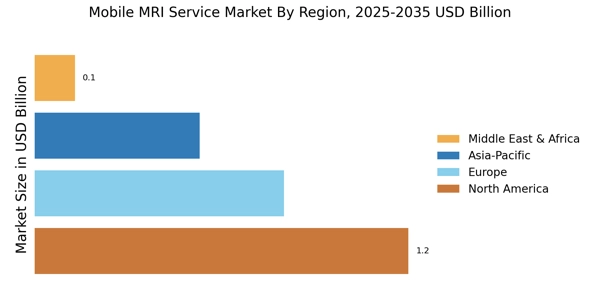Growing Aging Population
The demographic shift towards an aging population is a significant driver in the Mobile MRI Service Market. As individuals age, the prevalence of chronic conditions requiring advanced imaging increases. Mobile MRI services provide a convenient solution for elderly patients who may face mobility challenges in accessing traditional imaging facilities. Projections suggest that by 2030, the number of individuals aged 65 and older will reach approximately 1.5 billion, creating a substantial demand for accessible diagnostic services. This trend indicates that mobile MRI services will likely become an essential component of healthcare strategies aimed at addressing the needs of the aging population.
Increased Demand for Accessibility
Accessibility remains a critical driver in the Mobile MRI Service Market. As healthcare systems strive to provide equitable access to diagnostic services, mobile MRI units offer a viable solution for underserved populations. The ability to bring MRI services directly to patients in remote or rural areas addresses significant gaps in healthcare delivery. Recent data indicates that regions with limited access to traditional imaging facilities have seen a rise in mobile MRI deployments, enhancing patient convenience and compliance. This trend suggests that the demand for mobile MRI services will continue to grow, as healthcare providers recognize the importance of accessibility in improving patient care.
Cost-Effectiveness of Mobile Services
Cost considerations play a pivotal role in the Mobile MRI Service Market. Mobile MRI services often present a more cost-effective alternative to traditional imaging facilities, particularly for smaller healthcare providers. By eliminating the need for extensive infrastructure investments, mobile units allow facilities to offer MRI services without incurring significant overhead costs. Market analysis indicates that the operational costs associated with mobile MRI services can be up to 30% lower than those of fixed facilities. This financial advantage is likely to encourage more healthcare organizations to adopt mobile MRI solutions, thereby propelling the growth of the Mobile MRI Service Market.
Technological Advancements in Imaging
The Mobile MRI Service Market is experiencing a surge in technological advancements that enhance imaging capabilities. Innovations such as high-field MRI systems and advanced software algorithms improve image quality and diagnostic accuracy. These advancements not only facilitate better patient outcomes but also increase the efficiency of mobile MRI units. As of 2025, the integration of artificial intelligence in image analysis is projected to streamline workflows, potentially reducing the time required for scans. This technological evolution is likely to attract healthcare providers seeking to upgrade their imaging services, thereby driving growth in the Mobile MRI Service Market.
Regulatory Support for Mobile Health Services
Regulatory frameworks are increasingly supportive of mobile health services, including the Mobile MRI Service Market. Governments and health authorities are recognizing the value of mobile healthcare solutions in enhancing service delivery and patient outcomes. Recent policy initiatives aim to streamline the approval processes for mobile imaging units, facilitating their deployment in various settings. This regulatory support is expected to foster innovation and investment in mobile MRI technologies, potentially leading to an expansion of service offerings. As regulations evolve to accommodate the growing demand for mobile health solutions, the Mobile MRI Service Market is likely to experience accelerated growth.


















Leave a Comment